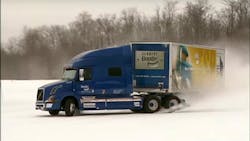Winter maintenance tips for braking systems
By Keith McComsey, Bendix Spicer Foundation Brake LLC
Every winter, Bendix Commercial Vehicle Systems LLC offers a series of “technical tips” aimed at helping fleets and owner-operators alike stave off potentially hazardous corrosion of brake system components due to cold temperatures and the impact of ice and snow removal chemicals. In this guest column, Keith McComsey, director of marketing and customer solutions for Bendix Spicer Foundation Brake LLC, offers insights gleaned from customer case studies and years of field research.
Across North America, it’s getting to be that time of year: Temperatures are dropping due to the influx of cold weather, so fleets and owner-operators are prepping for chilly conditions and wintry roads.
Winter can also be really tough on the components of air-braked systems: There’s added moisture on the roads in the form of snow and ice, and it’s often mixing with salt or corrosive chemicals used to keep highways clear.
Thus it’s important to prepare wheel-ends and air dryers for winter with a few steps that can help keep moisture, contaminants, and corrosion from gaining a foothold.
For starters, a clean air supply is crucial, regardless of whether the vehicle or trailer is equipped with foundation drum or air disc brakes, so the air tanks should be drained of moisture and the potential contaminants it can carry.
Remember that ambient temperature shifts of greater than 30 degrees Fahrenheit can cause a temporary accumulation of moisture, so if a significant temperature change took place in the previous 24 hours, continue to operate the vehicle as normal, and check the air system again after a week.
Winterizing drum brake components begins with a watchful eye: Check the chamber housings for corrosion or damage that could allow corrosive materials to take hold. Excessive corrosion can lead to failure of the housing. Next, verify that the chamber’s dust plug is properly installed to prevent contamination of the interior.
Effective lubrication keeps moisture at bay and is a powerful tool in the battle against corrosion. Make sure all automatic slack adjusters are properly greased, and lubricate the clevis pin connection points, verifying that they rotate freely. Ensure that other drum brake components are also lubricated, including cam tubes, shafts, and bushings.
Where air disc brakes or ADBs are concerned, begin with a visual inspection, checking the chamber housings and dust plug. Next, inspect the guide pins and look for cuts or tears on the boots, replacing them if necessary. Ripped or punctured boots can allow contaminants and moisture to enter the caliper, causing corrosion and long-term damage.
Part of prepping air disc brakes for winter operation also requires a few other important maintenance efforts:
- Pads move freely in the carrier – if not, remove them and clean the carrier surface with a wire brush.
- The brake moves freely on the guidance system – if not, replace the guidance system.
- Pads and rotors have enough remaining thickness to last until the next service interval – minimum rotor thickness is 37 millimeters (mm) while and minimum friction thickness is 2 mm.
Especially in cold or harsh climates, it’s usually a good idea to replace air dryer cartridges ahead of the winter months to prevent moisture from getting into the system and causing air brake freeze-up. If the vehicle has an oil-coalescing cartridge, always replace it with another oil-coalescing cartridge to maintain the quality of the air serving the brakes and other connected systems like automated manual transmissions.
You should also examine the air dryer’s purge valve for signs of corrosion or an accumulation of grit, and replacing it if necessary. Like a lot of winter preparation, it’s a simple procedure that can go a long way toward keeping a system operating safely, preventing malfunction and headaches down the road.
Finally some road-call advice if your brakes “freeze” during cold weather: while adding alcohol to unfreeze brake components is a “traditional” solution and may solve an immediate problem, it can damage seals in the air brake system, requiring additional unexpected service down the road. That’s why we don’t recommend using alcohol in air brake systems under any conditions.
